Time Theft: What It Is and How to Prevent It
Time theft is a growing epidemic in businesses from California to New York and a...
An employee time tracking app can be a valuable tool regardless of the type or size of business you operate.
Incorporating such an app into your workflow can help you maintain employee productivity, streamline the payroll process, bill clients more accurately, and stay within the bounds of labor compliance.
There are a number of great software options on the market, but some stand out above the rest. In this article, we discuss the top employee time tracking apps and software so you can choose the right one for your team and your business.
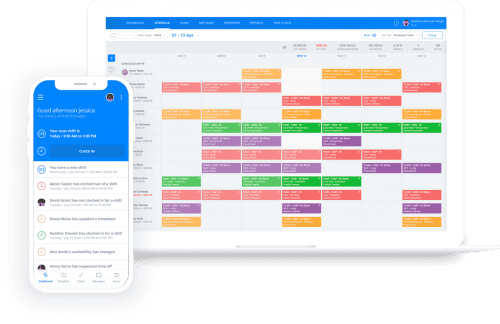
Source: GetSling.com
Sling is a full-featured employee time tracking app designed specifically with you, the busy manager, in mind. The foundation of the Sling app is its easy-to-use calendar view, built-in time clock, and cloud-based interface.
With just those three tools, you and your team can:
And that’s just the tip of the Sling iceberg.
Sling comes with other intuitive and useful features, such as employee and task color coding, advanced reports, time-off notices, and full-day and individual-task time tracking.
Sling even includes advanced communication tools that allow you to quickly and easily notify your team about no-shows and available shifts so that all work is covered.
The software is available on the web for smartphones, tablets, laptops, and desktops running iOS, MacOS, Android, and Windows, and includes a free, Premium, or Business option.
Sling comes with a 15-day free trial of the full product, after which scheduling and other basic features are free for up to 50 users. You can create a free Sling account here.
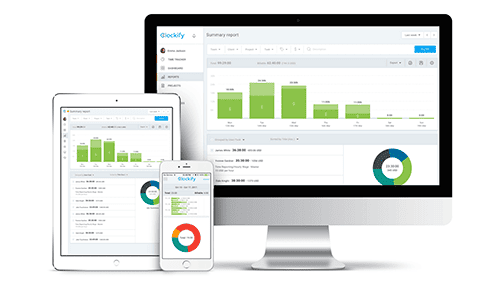
Source: Clockify.me
Clockify is an open-source employee time tracking app that can work for businesses with on-site and remote users.
The software has a range of features, including time tracking, reporting, and invoicing. Clockify also integrates with a number of popular apps, such as Slack, Trello, and Asana.
Clockify is available via web browser extension (Chrome, Firefox, Edge), desktop app (Mac, Windows, Linux), or mobile app (iOS, Android) and can be used on smartphones, tablets, laptops, and desktops.
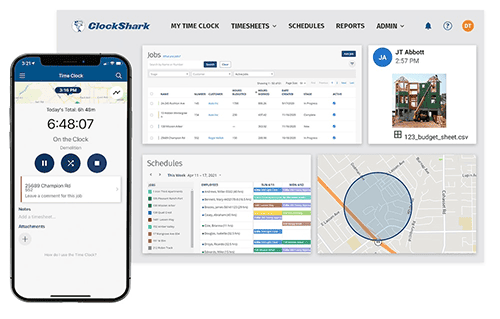
Source: Clockshark.com
ClockShark is time tracking software designed for field service businesses and their remote employees.
Managers know that it can be challenging to keep track of where their workers are and how their work is progressing. That’s why some businesses are switching to an employee time tracking app that their teams can use when they’re on the go.
ClockShark comes with a number of features that are specifically designed for businesses whose employees work outside the office, such as GPS tracking and timesheets that can be filled out offline.
Clockshark is available for smartphones, tablets, laptops, and desktops running iOS, Android, and Windows.
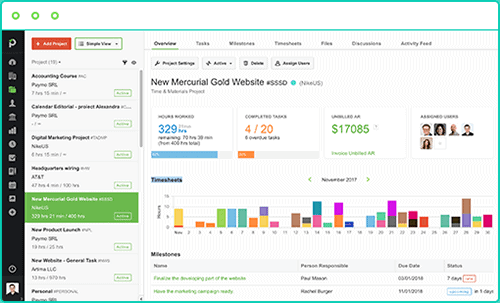
Source: Paymoapp.com
Looking for an employee time tracking app designed to track complex projects? Consider Paymo. Its user interface comes with features and tools that allow your team to track work hours for the projects to which you assign them.
You also get other project management tools, including task management and timesheets that can be broken down by category, task, job, and other increments.
Paymo is available on the web through a variety of devices and operating systems.
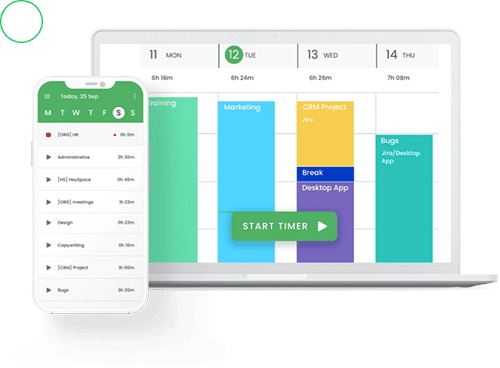
Source: Timecamp.com
With TimeCamp, you and your employees can log work hours automatically or manually to ensure that everything from payroll to customer billing is done with as much accuracy as possible.
And, when it comes to project management, TimeCamp provides data to analyze performance and help your team stay on track and work toward the same goal. TimeCamp also offers integrations with software you may already be using in your business.
Like other entries on this list, TimeCamp is available on the web via a variety of devices and operating systems and can be accessed through their website, Google Play, or the App Store.
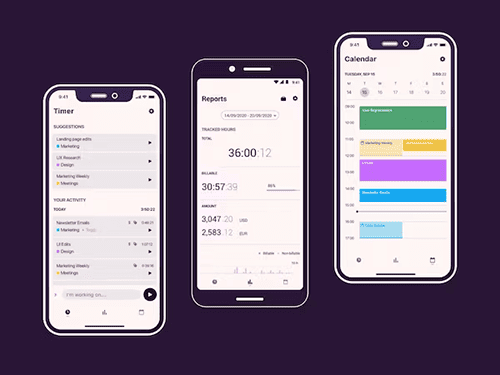
Source: Toggl.com
The Toggl Track app is software that can work for businesses large and small in a variety of industries.
With Toggl Track, your employees get access to such features as one-click start and stop as well as the ability to sync numbers across multiple platforms.
You also get billing and invoicing controls, project budgeting, reporting options, and payroll tools to help you manage your team.
Toggl Track is available on the web and via mobile and desktop apps through Google Play and the App Store.

Source: Rescuetime.com
RescueTime is an app centered on your team’s calendar and workday that tracks time and can also serve as a personal productivity assistant.
The software can assess individual work styles, work schedules, and other data points to help you and your team stay on track and headed toward the end goal.
You and your team also get access to tools that can minimize distractions that might pop up during the day.
RescueTime is available on the web or through Google Play and the App Store.
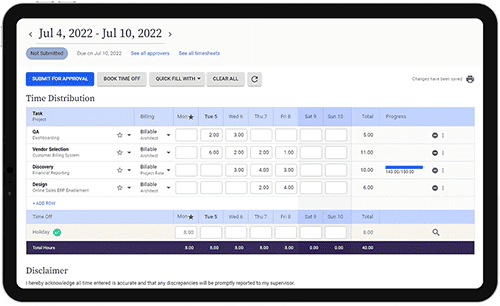
Source: Replicon.com
With Replicon, you and your team can automatically capture time and work data across a variety of apps and collaboration tools so you can see when and how your employees are working.
Replicon also offers tools that can help you manage workforce productivity, control project profitability, and eliminate the busy-work of filling out paper timesheets come payday.
Replicon is available on the web, Google Play, and the App Store.
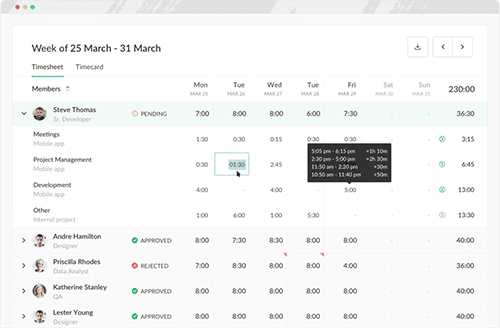
Source: Everhour.com
Everhour includes features such as time tracking, reporting and analysis, billing and budgeting, and basic task management.
You can also view your team’s schedule in such a way that you can see how busy someone is or what their availability might be in the near future.
The app can be used to track work-related expenses, use costs in project budgets, and create invoices based on tracked time and expenses.
You can access Everhour on the web and through Google Play or the App Store.

Source: 7shifts.com
7Shifts allows you and your team to track time for everything from daily work to special events (e.g. catering events, food truck rollouts, ghost restaurants, and more) so that everyone has a better understanding of how your business works.
Employees can access 7Shifts’ time clock software from a smartphone, tablet, laptop, desktop, or dedicated workstation.
In addition, managers can set the app to help prevent clock-ins from unscheduled employees, plan and track employee breaks, and remind employees to declare tips when they clock out.

While many employee time tracking software will work in a pinch, managers of successful restaurants know that what they really need is an app that is tailored to the unique needs of their industry.
So, before you settle for the first app you find, dig a bit deeper until you discover an app that will help you with time tracking and the many other aspects of your operation that depend on employee activity, productivity, and organization.
Look for employee time tracking software — like Sling — that is specifically designed for the food industry.
When it comes to your employee time tracking app (and the process that goes with it), one of the most important things you can do is make sure that your business is abiding by all local, state, and federal time tracking laws.
In many cases, those laws tell you exactly what you need to do to create a good (and legal) time tracking system so you don’t have to do it all yourself.
A lot of the work has already been done for you; all you need to do is build your own system so that it complies with the laws for your business and geographic location.
First, check all the necessary regulations your business needs to follow. Then, integrate state and local laws into the process to make sure all your bases are covered.
It’s also a good idea to consult an attorney who is familiar with the labor laws for your industry and your area. They can help you make sure your employee time tracking app, your time tracking system, and your business are all in full compliance.

Many work hour apps offer some level of automation to help managers and employees track time as accurately as possible.
Sling, for example, comes with integrated features that allow you to set the system to automatically apply certain variables to every clock-in/clock-out that occurs.
For example, you can:
Such automation streamlines the clock-in/clock-out process for employees, simplifies many of the backend details that can take up a lot of a manager’s time, and generally improves the time tracking and reporting process for all involved.
With the time that you and your team will save using some form of automation, you’ll all be better positioned to focus on the job itself rather than worrying about whether or not you tracked your time correctly.
For more information on the best way to harness the power of automation with your employee time tracking app, check out these articles from the Sling blog:
When it’s time to roll out a new employee time tracking app — or revise the system around an existing app — keep this principle in mind: Keep it simple!
It doesn’t matter how much automation the app offers or what special features it comes with, if the process for starting and stopping time is too complicated, employees won’t want to use it as fully as possible.
An overly complex system may add all sorts of unnecessary delays that your team members will have to navigate before they can get to work.
For example, if employees have to tap or click through six screens and enter five different pieces of information along the way, they’re likely going to become disenchanted — and maybe even irritated — with the process.
Whether you’re introducing a new system or revising an old one, try to keep the start/stop procedure to less than 15 seconds.
If it takes longer than that to clock in or out, the process is too complicated and needs to be simplified.
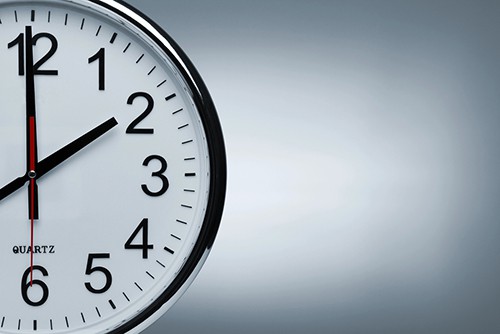
Within every good employee time tracking app, there should be a setting that dictates which format the software uses to record start and stop time.
In most cases, the two options are:
Standard format is the most common but the least useful for time tracking purposes because it starts over every twelve hours and relies on an indicator (i.e., a.m. and p.m.) to tell you what hours were worked.
Standard format also makes it more difficult to manually calculate the total hours worked if those hours occur in both the a.m. and the p.m. (which most shifts do).
Military format, on the other hand, starts over every 24 hours and doesn’t need an indicator to tell you whether it’s morning or evening.
In military format, mornings are displayed just like the standard format but without the a.m. (e.g., 8:14, 10:37, 11:51, etc.).
Afternoon and evening hours are displayed by adding hours to twelve. For example, 1:00 p.m. in standard format would be 13:00 in military format (12 + 1), 5:00 p.m. would be 17:00 (12 + 5), and 10:00 p.m. would be 22:00 (12 + 10).
The time format you choose may not have much impact on the employee side of things, but it can have a significant impact on the managerial side of things when it’s time to process timesheets.
Here’s how the two systems compare.
If Ted clocks in at 7:00 a.m. (standard format), has a one hour lunch break from noon to 1:00 p.m., and then clocks out at 5:00 p.m., his total work hours are not immediately evident and there’s not a straightforward way to find the information you need.
Instead, you have to subtract 7 from 12 (5), subtract 1 from 5 (4), and then add the 5 and 4 together to get 9 — Ted’s total work hours for the day.
Military format makes it simpler to manually calculate total hours worked regardless of when they occur.
Using the same example from earlier, if Ted clocks in at 07:00 (military format) and clocks out at 17:00 (5:00 p.m. in standard format), calculating his total time at work is now much easier because all you have to do is subtract 7 from 17 to get 10. Ted worked 10 hours that day.
If Ted took an hour lunch break, you would then subtract that hour from the total to reach 9 hours worked for the day.
One of the best things you can do to make it easier for managers and accounting personnel to figure out payroll is to incorporate rounding into the process.
To avoid the complexities that arise with recording small fractions of an hour (e.g., seven minutes), the federal government allows businesses to round up or down to the nearest 10- or 15-minute increment.
If your business chooses the 10-minute increment for tracking, payroll, and record keeping, the following would be true:
If, on the other hand, your business chooses the 15-minute increment, the following would be true:
Both of these options make calculating payroll much easier.
If rounding wasn’t allowed — or you don’t use it — and your business had to accommodate all numbers between one and 60, the calculations for payroll and other business metrics would be extremely tedious and unnecessarily complicated.
Take advantage of the 10- and 15-minute rounding laws to make payroll and record keeping easier.
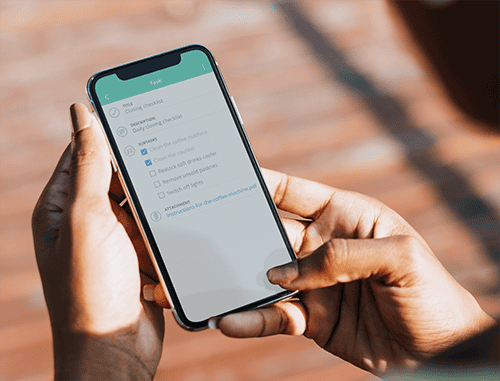
When choosing an employee time tracking app, it’s important to consider your specific needs and requirements.
Sure, you might not need more advanced features right now, but as your business grows, it’s always beneficial to have options at the ready to prevent speed bumps and bottlenecks from slowing down your workflow.
Select a software that makes it easy to track, organize, and optimize complicated tasks like maintaining and accessing employee documents, monitoring labor compliance, and coordinating employee breaks.
And, if you choose an app that works in the cloud, your team will be set and ready to access the data they need on a wide array of devices and operating systems, wherever the job may take them.
Don’t wait for problems to arise before looking for solutions. Plan ahead with the right employee time tracking app and you’ll be ready to guide your team and your business to the next level.
For more free resources to help you manage your business better, organize and schedule your team, and track and calculate labor costs, visit GetSling.com today.
This content is for informational purposes and is not intended as legal, tax, HR, or any other professional advice. Please contact an attorney or other professional for specific advice.
See Here For Last Updated Dates: Link
Schedule faster, communicate better, get things done.